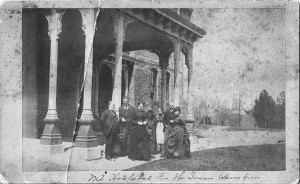Nearly every patient in an insane asylum wanted out. Asylum superintendents often put up roadblocks to this when they didn’t feel a patient was well enough to go home; there are many accounts of clashes between the asylum’s medical staff advising against removal, and patients’ families who thought they looked or seemed well enough to come home. No one can determine who was right or wrong so many years later.
Superintendents may have had a point, since they realized patients would usually be on their best behavior during a visit, even though they were still too fragile to withstand the pressures waiting on them at home. Families had a point as well, since they felt they knew their loved ones best and whether or not they were able to come home successfully.
Sometimes other factors worked against patients. A “very old” (only 65) woman at the Canton Asylum for Insane Indians wanted to go home, and her daughter had offered to care for her if she did. The asylum’s superintendent, Dr. Harry Hummer, agreed that there would be no difficulty in releasing her. “I know of no important reason why their wishes should not be granted,” he wrote to the Commissioner of Indian Affairs. “Her mental condition is as comfortable as it ever will be . . . and it would seem to me that she should be allowed to make her home with her people . ..”
Unfortunately, the superintendent of her agency wrote a letter to the Commissioner, advising against the woman’s release. He wrote that the patient’s husband wanted to divorce her, and relatives felt that if she returned, he could not do so. Her husband further stated that he would be glad to care for her, but thought she wouldn’t be happy with him and would travel from the home of one of her children to the next. In a short time, the husband said, “it would be necessary to have her returned, as the influence the children would have upon her would not be beneficial to her health.”
This letter was written in 1920, and on its basis, the woman remained at Canton Asylum until it closed and she was transferred to St. Elizabeths Hospital.








